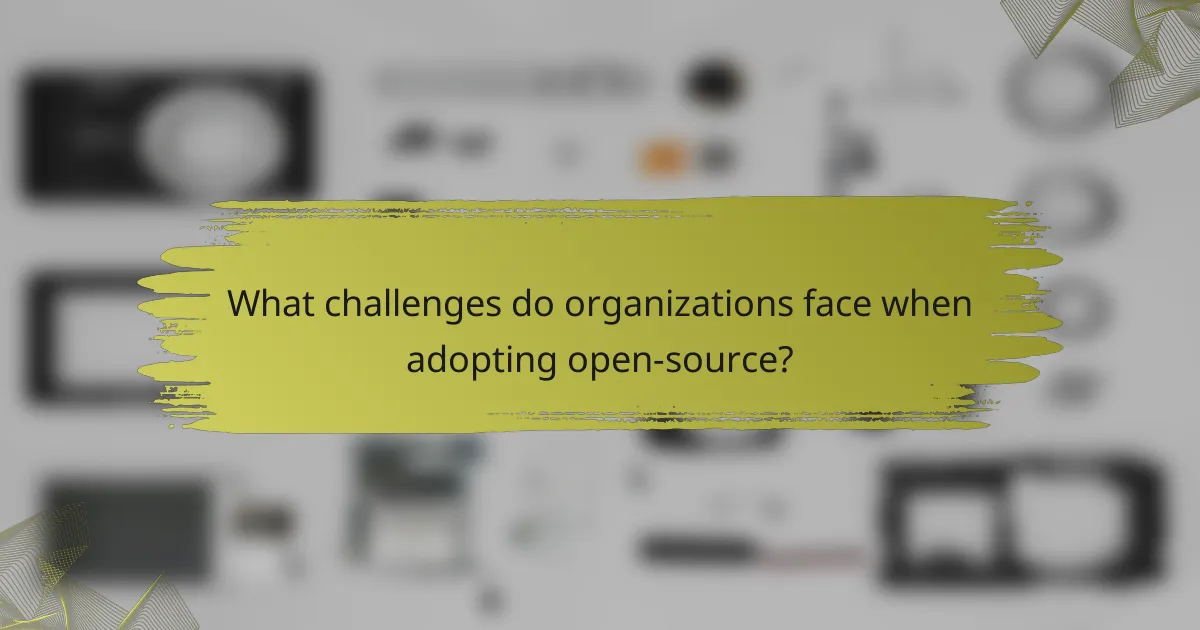Open-source software is revolutionizing industries by promoting collaboration, lowering costs, and spurring innovation. As organizations increasingly adopt open-source solutions, they benefit from community-driven resources that enhance flexibility and operational efficiency. Key sectors such as technology, healthcare, and financial services are leading the way in this transformative trend, utilizing open-source technologies to drive progress and improve outcomes.

How is open-source software influencing industries in the US?
Open-source software is significantly shaping industries in the US by fostering collaboration, reducing costs, and driving innovation. Its influence is evident across various sectors, enabling companies to leverage community-driven resources and solutions.
Increased collaboration among developers
Open-source software promotes a collaborative environment where developers can contribute to projects without the barriers of proprietary licenses. This collaboration leads to shared knowledge and skills, enhancing the overall quality of software development.
For example, platforms like GitHub allow developers to work together on projects from different locations, facilitating real-time feedback and improvements. This collective effort often results in faster problem-solving and more robust software solutions.
Cost savings for businesses
Utilizing open-source software can lead to significant cost savings for businesses, as it eliminates the need for expensive licensing fees associated with proprietary software. Companies can allocate these savings towards other critical areas such as development and marketing.
Many organizations report reductions in software costs by upwards of 50% when switching to open-source alternatives. Additionally, businesses can avoid vendor lock-in, giving them greater flexibility in choosing solutions that best meet their needs.
Enhanced innovation through community contributions
The open-source model encourages innovation by allowing developers from diverse backgrounds to contribute ideas and improvements. This influx of creativity often leads to rapid advancements in technology, as solutions can be iterated upon quickly.
For instance, the development of frameworks like TensorFlow has been accelerated by contributions from both individual developers and large organizations. This collaborative innovation not only benefits the software itself but also drives industry-wide advancements in technology and practices.

What are the key trends in open-source adoption?
Key trends in open-source adoption include the growing integration of open-source solutions in various industries, driven by the need for flexibility, cost-effectiveness, and community collaboration. Organizations are increasingly leveraging open-source technologies to enhance innovation and streamline operations.
Growth of cloud-native technologies
The growth of cloud-native technologies is a significant trend in open-source adoption, as businesses seek scalable and efficient solutions. Cloud-native applications are designed to fully exploit cloud computing benefits, allowing for rapid deployment and improved resource management.
Popular open-source cloud-native projects include Kubernetes for container orchestration and OpenShift for application development. These tools enable organizations to build, deploy, and manage applications in a cloud environment effectively.
Rise of AI and machine learning frameworks
The rise of AI and machine learning frameworks is reshaping open-source adoption, with many organizations turning to open-source tools for their data science needs. Frameworks like TensorFlow and PyTorch provide robust environments for developing machine learning models, fostering collaboration and innovation.
Using open-source AI frameworks allows companies to customize solutions to their specific requirements while benefiting from community support and shared advancements. This trend is particularly evident in sectors such as healthcare, finance, and marketing, where data-driven insights are crucial.
Increased focus on security and compliance
As open-source adoption grows, there is an increased focus on security and compliance to mitigate risks associated with vulnerabilities. Organizations are implementing best practices such as regular audits, vulnerability assessments, and adherence to established security standards.
Tools like OWASP Dependency-Check and Snyk help identify and remediate security issues in open-source components. Additionally, compliance with regulations such as GDPR and HIPAA is essential for organizations using open-source software in sensitive environments.

Which industries are leading in open-source adoption?
Several industries are at the forefront of open-source adoption, including technology, healthcare, and financial services. These sectors leverage open-source solutions to enhance innovation, reduce costs, and improve collaboration.
Technology sector
The technology sector is the most prominent adopter of open-source software, driven by a culture of collaboration and innovation. Companies like Google, Facebook, and Microsoft actively contribute to and utilize open-source projects, fostering a vast ecosystem of tools and frameworks.
Key considerations for tech companies include evaluating the security and support of open-source solutions. While many projects are robust, some may lack comprehensive documentation or community support, which can impact development timelines.
Healthcare industry
In the healthcare industry, open-source adoption is growing as organizations seek to improve patient care and streamline operations. Open-source software can facilitate data sharing and interoperability among various health systems, which is crucial for effective patient management.
Healthcare providers should consider compliance with regulations such as HIPAA in the U.S. when implementing open-source solutions. Ensuring that data privacy and security measures are in place is essential to protect sensitive patient information.
Financial services
The financial services sector is increasingly turning to open-source technologies to enhance security and reduce costs. Institutions are adopting open-source solutions for risk management, trading platforms, and regulatory compliance, benefiting from community-driven innovation.
Financial organizations must carefully assess the risks associated with open-source software, particularly regarding security vulnerabilities. Regular updates and community engagement are crucial to maintaining the integrity of these systems.

What challenges do organizations face when adopting open-source?
Organizations often encounter several challenges when adopting open-source solutions, including integration with existing systems, skill gaps in the workforce, and licensing and compliance issues. Addressing these challenges is crucial for successful implementation and maximizing the benefits of open-source software.
Integration with existing systems
Integrating open-source software with legacy systems can be complex and time-consuming. Organizations must assess compatibility and potential disruptions to current operations, which may require additional resources for testing and troubleshooting.
To facilitate smoother integration, it is advisable to conduct a thorough analysis of existing infrastructure and identify any necessary modifications. Utilizing middleware or APIs can also help bridge the gap between new open-source solutions and legacy systems.
Skill gaps in workforce
A significant challenge in adopting open-source software is the skill gap within the workforce. Many employees may lack the necessary expertise to implement and maintain open-source solutions effectively, which can hinder adoption and lead to underutilization.
Organizations should consider investing in training programs or hiring specialists with open-source experience. Collaborating with community resources or participating in open-source projects can also help build internal capabilities and foster a culture of continuous learning.
Licensing and compliance issues
Open-source software comes with various licensing agreements that organizations must understand to ensure compliance. Misinterpretation of licenses can lead to legal issues or unintended restrictions on software use.
To navigate these challenges, organizations should establish clear policies for evaluating and managing open-source licenses. Utilizing tools that automate license compliance checks can also help mitigate risks and ensure adherence to legal requirements.

What are the best practices for successful open-source implementation?
Successful open-source implementation hinges on establishing governance, fostering community involvement, and providing adequate training and support. These practices ensure that projects remain sustainable, collaborative, and effective over time.
Establishing clear governance
Clear governance structures are essential for guiding open-source projects. They define roles, responsibilities, and decision-making processes, which help prevent conflicts and ensure accountability among contributors.
Consider creating a governance model that includes a steering committee or a set of maintainers. This can help streamline contributions and maintain project direction, especially as the community grows.
Encouraging community engagement
Community engagement is vital for the success of open-source projects. Actively involving users and contributors fosters a sense of ownership and encourages collaboration, leading to more robust and innovative solutions.
To boost engagement, host regular meetings, provide forums for discussion, and create opportunities for contributors to showcase their work. Recognizing contributions through acknowledgments or rewards can also enhance motivation.
Investing in training and support
Providing training and support is crucial for onboarding new contributors and maintaining project momentum. This investment helps users understand the project’s goals, tools, and workflows, ultimately leading to higher quality contributions.
Offer comprehensive documentation, tutorials, and mentorship programs to assist new contributors. Regular workshops or webinars can also be effective in building skills and fostering a collaborative environment.



